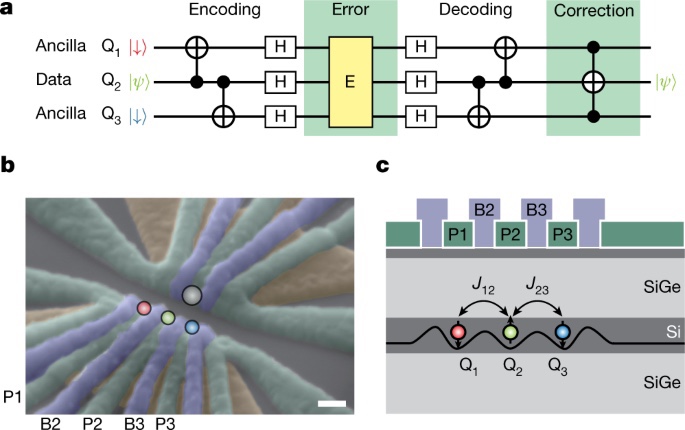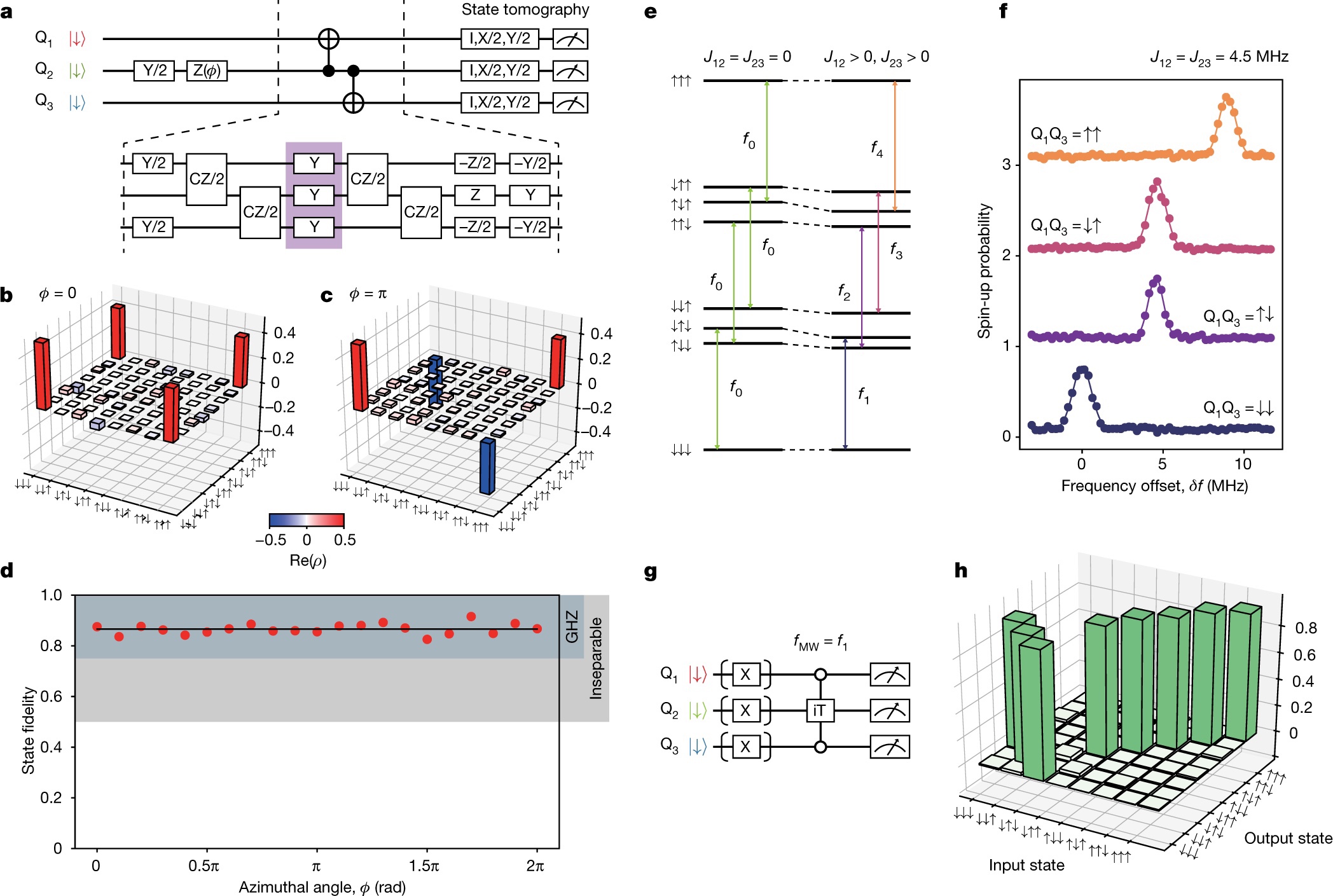

RIKEN: Achieving quantum error correction with Si qubits!
ーMicrofabrication of Silicon/Silicon Germanium Semiconductor Substratesー
RIKEN
RIKEN Center for Emergent Matter Science
Quantum Functional System Research Group
The research team
Using electron spins [2] in silicon quantum dot [1] devices,
demonstrated 3-qubit quantum error correction [3].
quantum computer
error correction technology
quantum computer
By their very nature, error-prone,
Error correction technology is considered necessary for practical quantum computation.
Full control of three qubits:
So far, basic operations up to two qubits have been realized.
“Completely controlling at least three qubits necessary for quantum error correction with high precision” is
It was difficult.
A qubit using electron spin:
“In Silicon Quantum Dot Devices”
Using “quantum bits using electron spin”,
“Implementing basic quantum error correction using a 3-qubit gate”
The world’s first success.
Quantum dot structure:
silicon quantum computer,
On a common silicon/silicon germanium semiconductor substrate [6],
It was produced by applying microfabrication (Fig. 1).
By “controlling the voltage applied to the gate electrode”,
It is possible to “form quantum dots with a high degree of freedom and control the state of electron spins.”
RIKEN
https://www.riken.jp/press/2022/20220825_1/index.html
RIKEN : Réaliser une correction d’erreur quantique avec les qubits Si !
ーMicrofabrication de substrats semi-conducteurs silicium/silicium germaniumー
RIKEN
Centre RIKEN pour la science de la matière émergente
Groupe de recherche sur les systèmes fonctionnels quantiques
L’équipe de recherche
En utilisant des spins d’électrons [2] dans des dispositifs à points quantiques en silicium [1],
a démontré une correction d’erreur quantique à 3 qubits [3].
ordinateur quantique
technologie de correction d’erreurs
ordinateur quantique
De par leur nature même, sujets aux erreurs,
La technologie de correction d’erreur est considérée comme nécessaire pour le calcul quantique pratique.
Contrôle total de trois qubits :
Jusqu’à présent, des opérations de base jusqu’à deux qubits ont été réalisées.
“Contrôler complètement au moins trois qubits nécessaires à la correction d’erreur quantique avec une grande précision” est
C’était difficile.
Un qubit utilisant le spin électronique :
“Dans les dispositifs à points quantiques en silicium”
En utilisant des “bits quantiques utilisant le spin électronique”,
“Mise en œuvre de la correction d’erreur quantique de base à l’aide d’une porte à 3 qubits”
Premier succès mondial.
Structure de points quantiques :
ordinateur quantique au silicium,
Sur un substrat semi-conducteur commun silicium/silicium-germanium [6],
Il a été produit en appliquant la microfabrication (Fig. 1).
En « contrôlant la tension appliquée à l’électrode de grille »,
Il est possible de “former des points quantiques avec un haut degré de liberté et de contrôler l’état des spins des électrons”.
RIKEN
RIKEN: Quantenfehlerkorrektur mit Si-Qubits erreichen!
ーMikrofabrikation von Silizium/Siliziumgermanium-Halbleitersubstratenー
RIKEN
RIKEN Center for Emergent Matter Science
Forschungsgruppe Quantenfunktionale Systeme
Das Forschungsteam
Verwendung von Elektronenspins [2] in Silizium-Quantenpunkt-Geräten [1],
demonstrierte die 3-Qubit-Quantenfehlerkorrektur [3].
Quantencomputer
Fehlerkorrekturtechnologie
Quantencomputer
Von Natur aus fehleranfällig,
Die Fehlerkorrekturtechnologie wird für die praktische Quantenberechnung als notwendig erachtet.
Volle Kontrolle über drei Qubits:
Bisher wurden grundlegende Operationen bis zu zwei Qubits realisiert.
“Die vollständige Kontrolle von mindestens drei Qubits, die für die Quantenfehlerkorrektur mit hoher Präzision erforderlich sind” ist
Es war schwer.
Ein Qubit mit Elektronenspin:
“In Silizium-Quantenpunktgeräten”
Verwendung von “Quantenbits mit Elektronenspin”,
“Implementierung grundlegender Quantenfehlerkorrektur mit einem 3-Qubit-Gatter”
Der erste Erfolg der Welt.
Quantenpunktstruktur:
Silizium-Quantencomputer,
Auf einem gemeinsamen Silizium/Siliziumgermanium-Halbleitersubstrat [6],
Es wurde durch Mikrofabrikation hergestellt (Abb. 1).
Durch “Steuern der an die Gate-Elektrode angelegten Spannung”,
Es ist möglich, “Quantenpunkte mit einem hohen Freiheitsgrad zu bilden und den Zustand von Elektronenspins zu steuern”.
RIKEN
Scientists achieve key elements for fault-tolerant quantum computation in silicon spin qubits | RIKEN
https://www.riken.jp/en/news_pubs/research_news/pr/2022/20220120_1/index.html
Quantum error correction with silicon spin qubits
Nature
AbstractFuture large-scale quantum computers will rely on quantum error correction (QEC)
to protect the fragile quantum information during computation1,2.
Among the possible candidate platforms for realizing quantum computing devices,
the compatibility with mature nanofabrication technologies of silicon-based spin qubits
offers promise to overcome the challenges in scaling up device sizes from the prototypes of today to large-scale computers3,4,5.Recent advances in silicon-based qubits have enabled
the implementations of high-quality one-qubit and two-qubit systems6,7,8.However,
the demonstration of QEC, which requires three or more coupled qubits1,
and involves a three-qubit gate9,10,11 or measurement-based feedback, remains an open challenge.Here we demonstrate a three-qubit phase-correcting code in silicon,
in which an encoded three-qubit state is protected against any phase-flip error on one of the three qubits.The correction to this encoded state is performed by a three-qubit conditional rotation,
which we implement by an efficient single-step resonantly driven iToffoli gate.As expected,
the error correction mitigates the errors owing to one-qubit phase-flip, as well as the intrinsic dephasing mainly owing to quasi-static phase noise.These results show successful implementation of QEC and the potential of a silicon-based platform for large-scale quantum computing.
Nature